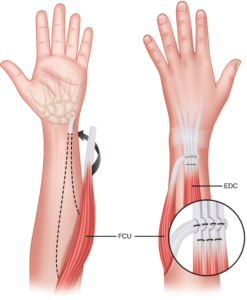Tendon Transfer Surgery

Introduction:
Tendon transfer surgery is a specialized procedure performed by Hand Surgeons to restore function and improve mobility in individuals with tendon injuries or conditions affecting the hand. Dr. Chaitanya Karande, a leading Hand Surgeon in Pune, possesses expertise in tendon transfer surgery and offers comprehensive care to patients seeking relief from hand-related conditions. In this article, we will explore the anatomy, diagnosis, causes, and recovery associated with tendon transfer surgery.
Anatomy of Tendon Transfer Surgery:
Understanding the anatomy of the hand is crucial in comprehending tendon transfer surgery. The hand consists of various tendons, which are the fibrous tissues that connect muscles to bones. Tendons play a vital role in facilitating movement and stability. Tendon transfer surgery involves transferring a functional tendon from one area to another to restore lost function. This technique harnesses the body’s ability to adapt and compensate, allowing for improved hand function.
Diagnosis of Tendon Injuries:
Hand surgeons, like Dr. Chaitanya Karande, utilize their expertise to diagnose tendon injuries accurately. Tendon injuries can occur due to trauma, repetitive strain, or degenerative conditions. Common symptoms include pain, swelling, restricted movement, and weakness in the affected hand. The diagnostic process may involve a thorough physical examination, imaging tests such as X-rays or MRI scans, and assessing the patient’s medical history. Accurate diagnosis enables the Hand Surgeon to determine whether tendon transfer surgery is a suitable treatment option.
Causes of Tendon Transfer Surgery:
Tendon transfer surgery is performed for various conditions affecting hand function. Some common causes include:
- Tendon Rupture: Trauma or injury can cause a tendon to rupture or tear, leading to functional impairment.
- Tendon Laceration: Deep cuts or lacerations can sever tendons, necessitating surgical intervention.
- Nerve Damage: Nerve injuries can result in muscle weakness or paralysis. Tendon transfer surgery may be performed to restore function by utilizing alternative tendon sources.
- Chronic Conditions: Certain chronic conditions, such as tendonitis or rheumatoid arthritis, can cause tendon damage or deformities, requiring surgical correction through tendon transfer.
Recovery after Tendon Transfer Surgery:
The recovery process following tendon transfer surgery is crucial for achieving optimal results. While recovery timelines may vary depending on the specific procedure and individual factors, the following general steps are involved:
- Immobilization and Protection: After surgery, the hand may be immobilized with a splint or cast to protect the surgical site and promote healing. It is essential to follow the surgeon’s instructions regarding immobilization and protect the hand from excessive strain or movement during the initial healing phase.
- Rehabilitation and Therapy: Once the initial healing phase is complete, a structured rehabilitation program is initiated. This program includes physical therapy exercises aimed at gradually restoring hand function, improving strength, and promoting flexibility. Regular therapy sessions and home exercises play a crucial role in the recovery process.
- Functional Recovery: Over time, as the transferred tendon adapts and integrates into its new position, functional recovery occurs. Patients may experience improved grip strength, range of motion, and overall hand function. The duration of functional recovery varies from patient to patient, and regular follow-up visits with the Hand Surgeon are essential to monitor progress and make any necessary adjustments to the rehabilitation plan.
Conclusion:
Tendon transfer surgery is a specialized procedure performed by Hand Surgeons to restore hand function and mobility. Dr. Chaitanya Karande, a skilled Hand Surgeon in Pune, possesses expertise in tendon transfer surgery and offers comprehensive care to patients in need.

